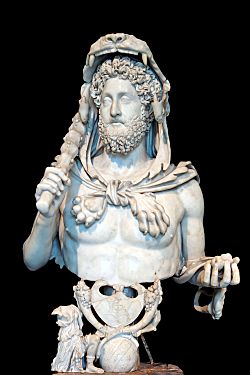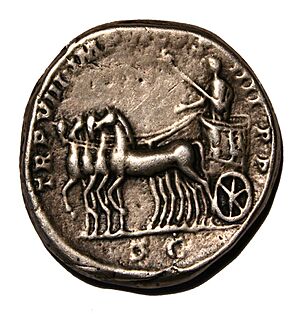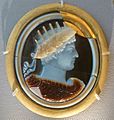Commodus facts for kids
Quick facts for kids Commodus |
|||||
|---|---|---|---|---|---|
| Emperor of the Roman Empire | |||||

Commodus as Hercules,
Capitoline Museums |
|||||
| Reign | 177 – 17 March 180 (with Marcus Aurelius); 18 March 180– 31 December 192 (alone) |
||||
| Predecessor | Marcus Aurelius | ||||
| Successor | Pertinax | ||||
| Born | 31 August 161 Lanuvium |
||||
| Died | 31 December 192 (aged 31) Rome |
||||
| Burial | Rome | ||||
| Spouse | Bruttia Crispina | ||||
|
|||||
| Dynasty | Antonine | ||||
| Father | Marcus Aurelius | ||||
| Mother | Faustina | ||||
Commodus (Lucius Aurelius Commodus Antoninus, born August 31, 161 – died December 31, 192) was a Roman Emperor. He ruled from 180 to 192. Before that, he was a co-emperor with his father, Marcus Aurelius, from 177 until his father passed away in 180.
Commodus was the first emperor to be born while his father was already ruling. This was called being "born to the purple." It meant he was born into the imperial family. His becoming emperor was also the first time a son had followed his father since Titus became emperor after Vespasian in 79 AD.
Contents
Commodus's Time as Emperor (180–192)
Commodus's father, Marcus Aurelius, spent most of his rule fighting wars. But Commodus's time as emperor was much more peaceful in terms of battles. However, it was full of political problems. Commodus himself often acted in strange and unpredictable ways.
A writer named Dio Cassius, who lived at the same time, said that Commodus's rule was like going "from a kingdom of gold to one of rust and iron." This meant things got much worse for the Roman Empire. The historian Edward Gibbon also thought Commodus's reign was the start of the Roman Empire's decline.
Even though Commodus was well-known, there are not many detailed records about his years in power. He stayed with the Roman armies near the Danube River for a short time. Then he made a peace treaty with the local tribes there. After that, he went back to Rome and celebrated a victory parade on October 22, 180.
Unlike earlier emperors like Trajan and Marcus Aurelius, Commodus was not very interested in running the government. He let other people, called "favourites," handle state affairs. His first favourite was Saoterus, a former slave who became his personal assistant.
This way of ruling led to many plots and attempts to overthrow Commodus. These events eventually made Commodus take more control. He started to rule in a very strict and demanding way.
Even though the Senate (a group of powerful Roman leaders) came to dislike and fear him, Commodus seemed popular with the army and common people. He gave out many gifts, which were even shown on his coins. He also put on amazing gladiator fights and even took part in them himself.
To pay for these big shows, he often taxed the senators heavily. On many official writings, the usual order of "Senate and People of Rome" was changed to "People and Senate." This showed his power over the Senate.
Plots Against the Emperor in 182
When Commodus became emperor, he was only 19 years old. He kept many of his father's trusted advisors. He also had five older sisters. Their husbands could have been rivals for the throne. His oldest sister, Lucilla, was a very important woman.
The first big problem of his rule happened in 182. Lucilla planned to overthrow her brother. People said she was jealous of Commodus's wife, Empress Crispina. Lucilla's husband was not involved. But two men, who were said to be close to Lucilla, tried to kill Commodus. They attacked him as he was entering a theater.
However, they failed. Commodus's bodyguards quickly caught and executed them. Lucilla was sent away to an island called Capri and later killed. One of the two commanders of the Praetorian Guard (the emperor's personal guards), Tarrutenius Paternus, was part of the plot. But he was not caught at that time.
After this, Paternus and his fellow commander, Sextus Tigidius Perennis, arranged for Saoterus, the emperor's disliked assistant, to be murdered. Commodus was very upset about losing Saoterus. Perennis then used this chance to get rid of Paternus. He made it look like Paternus was involved in another plot. More people were executed.
Perennis then took control of the government. Commodus found a new assistant and favourite named Cleander. Cleander was a former slave who had married one of the emperor's girlfriends. It was Cleander who had actually killed Saoterus.
After these attempts on his life, Commodus spent a lot of time outside Rome. He mostly stayed at his family's estates. He was physically strong but not very interested in serious work. His main hobby was sports. He enjoyed horse racing, chariot racing, and fighting animals and people. He did this mostly in private, but sometimes in public shows.
Trouble in Britain
In Britain in 184, the Roman governor Ulpius Marcellus pushed the Roman border further north. But his soldiers rebelled because he was too strict. Perennis had all the army commanders in Britain removed from their jobs.
On October 15, 184, during some games in Rome, a philosopher spoke out against Perennis in front of Commodus. The philosopher was immediately put to death. According to Dio Cassius, Perennis was a tough and ambitious man. But he was not personally corrupt and generally ran the government well.
However, the next year, some soldiers from Britain came to Italy. They had been sent to stop robbers. These soldiers accused Perennis of planning to make his own son emperor. Cleander helped them do this because he wanted to get rid of Perennis. Commodus gave the soldiers permission to execute Perennis and his family.
The fall of Perennis led to many more executions. Ulpius Marcellus was replaced as governor of Britain by Pertinax. Marcellus was brought to Rome and put on trial for treason. He barely escaped being killed.
Cleander's Rise and Fall (185–190)
Cleander took power into his own hands. He became very rich by selling important government jobs. He sold positions in the Senate, army commands, and even governorships to the highest bidder.
Problems grew across the Roman Empire. Many army soldiers left their posts and caused trouble in Gaul (modern France) and Germany. A rebellion in Brittany was stopped by two Roman armies brought from Britain. In 187, one of the rebel leaders, Maternus, came from Gaul. He planned to kill Commodus at a festival in March. But he was betrayed and executed.
In the same year, Pertinax uncovered a plot by two enemies of Cleander. Because of this, Commodus appeared in public even less often. He preferred to live on his country estates. In early 188, Cleander got rid of the current commander of the Praetorian Guard. He then took over supreme command of the Praetorians himself. He was now at the peak of his power.
Cleander continued to sell public offices as his own private business. The most extreme example was in 190. That year, 25 people were appointed as temporary consuls. This was a record in the 1,000-year history of the Roman consulship. All of them were appointed by Cleander. One of them was the future Emperor Septimius Severus.
In the spring of 190, Rome suffered from a food shortage. The official in charge of the grain supply managed to blame Cleander for it. At the end of June, a large crowd protested against Cleander during a horse race. Cleander sent the Praetorian Guard to stop the protests. But Pertinax, who was now the City Prefect of Rome, sent his own police force to fight them.
Cleander ran to Commodus for protection. Commodus was staying at a house outside Rome. But the crowd followed Cleander, demanding his death. Commodus's mistress, Marcia, urged him to act. So, Commodus had Cleander beheaded and his son killed. Other people who died at this time included a Praetorian commander, Commodus's cousin, and his brother-in-law.
Commodus continued to rule through a small group of trusted people. This group now included Marcia, his new assistant Eclectus, and the new Praetorian commander Quintus Aemilius Laetus. Around this time, Laetus also had many Christians freed from working in mines. Marcia was said to be a Christian.
A New Order (190–192)
In 191, a large fire badly damaged the city of Rome. It burned for several days. Many public buildings were destroyed, including the Temple of Peace and parts of the imperial palace.
Commodus presented himself as the most important person in the Empire. He even had the head of the giant Colossus of Nero statue, which was next to the Colosseum, replaced with his own face. He gave the statue a club and placed a bronze lion at its feet, making it look like Hercules. He also added an inscription that boasted about him being "the only left-handed fighter to conquer twelve times one thousand men."
Commodus the Gladiator
The emperor loved gladiatorial combat. He even went into the arena himself, dressed as a gladiator. The Romans found Commodus fighting as a gladiator to be very shocking and shameful. There were rumors that he was not actually the son of Marcus Aurelius. Instead, people whispered that his mother had a gladiator as a lover.
In the arena, Commodus always won his fights. His opponents always gave up to the emperor. This meant these public fights never ended in death. For each time he appeared in the arena, he charged the city of Rome a million sesterces. This put a lot of strain on the Roman economy.
Assassination
In November 192, Commodus held special games. Every morning, he would shoot hundreds of animals with arrows and spears. Every afternoon, he fought as a gladiator, and of course, he won all his matches. In December, he announced that he planned to start the year 193 as both a consul (a top Roman official) and a gladiator.
At this point, the Praetorian commander Laetus formed a plot with Eclectus to replace Commodus with Pertinax. They also brought Marcia into their plan. On December 31, Marcia tried to poison Commodus's food. But he vomited up the poison. So, the plotters sent his wrestling partner, Narcissus, to strangle him in his bath.
After Commodus's death, the Senate declared him a public enemy. They restored the original names to the city of Rome and its institutions. Commodus's statues were torn down.
Pertinax succeeded Commodus. However, Pertinax's rule was very short. He was the first victim of a period known as the "Year of the Five Emperors." Commodus's death marked the end of the Nervan-Antonian dynasty. It also signaled the beginning of the end for the Western Roman Empire.
Commodus in Popular Culture
There are a few movies that tell a story about Commodus's life. They are not completely historically accurate. The most famous ones are:
- In the 1964 movie The Fall of the Roman Empire, Christopher Plummer plays Commodus. This movie is quite long, about three hours. It is now seen as a classic film. One big difference from history is that the movie shows Marcus Aurelius planning to disinherit Commodus. He wanted to adopt a step-son instead. This makes for good drama in the movie.
- The 2000 movie Gladiator won an Academy Award for Best Picture. Russell Crowe stars as Maximus, and Joaquin Phoenix plays Commodus. In the movie, Commodus is the main bad guy. He is shown as being cowardly, greedy, and cruel.
The movie is only loosely based on real historical events. The filmmakers did talk to an expert about ancient Rome. But they still changed many historical facts for the story. At least one historical advisor quit because of the changes. Another asked not to be mentioned in the movie credits. Some historians believe that being more accurate would not have made Gladiator less interesting. The movie starts with an exciting battle scene. It uses modern computer graphics. This battle also plays with history. Much of the fighting is shown as one-on-one duels between soldiers. The highly organized Roman army would not have fought this way. They would have used their organized formations to defeat their enemies. The movie ends with both Commodus and Maximus dying in the arena.
Images for kids
-
A carving of Commodus with symbols of Roman gods, from the late 2nd century AD. It is made of sardonyx and is in the Hermitage Museum.
-
Parts of a Roman statue of a young man with a blond beard. It might show Emperor Commodus. This is at the National Archaeological Museum, Athens.
-
An inscription in Germany where Commodus's name was removed after his death. This was called Damnatio memoriae.
See also
 In Spanish: Cómodo para niños
In Spanish: Cómodo para niños










